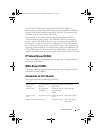
770 VLAN Commands
two TPID values can be different or the same. VLAN normalization, source
MAC learning, and forwarding are based on the S-TAG value in a received
frame.
PowerConnect supports configuring one outer VLAN TPID value per switch.
The global default TPID is 0x88A8, which indicates a Virtual Metropolitan
Area Network (VMAN).
Independent VLAN Learning
Independent VLAN Learning (IVL) allows unicast address-to-port mappings
to be created based on a MAC Address in conjunction with a VLAN ID.
This arrangement associates the MAC Address only with the VLAN on which
the frame was received. Therefore, frames are forwarded based on their
unicast destination address as well as their VLAN membership. This
configuration affords multiple occurrences of an address in the forwarding
database. Each address associates with a unique VLAN. Care must be taken
in the administration of networks, as multiple instances of a MAC address,
each on a different VLAN, can quickly eat up address entries.
Each VLAN is associated with its own forwarding database. Hence the
number of forwarding databases equals the number of VLANs supported.
The MAC address stored is supplemented by a 2-byte VLAN ID. The first 2
bytes of a forwarding database entry contain the VLAN ID associated, and the
next 6 bytes contain the MAC address. There is a one-to-one relationship
between VLAN ID and FID (forwarding database ID).
Protocol Based VLANs
The main purpose of Protocol-based VLANs (PBVLANs) is to selectively
process packets based on their upper-layer protocol by setting up protocol-
based filters. Packets are bridged through user-specified ports based on their
protocol.
In PBVLANs, the VLAN classification of a packet is based on its protocol (IP,
IPX, NetBIOS, and so on). PBVLANs help optimize network traffic because
protocol-specific broadcast messages are sent only to end stations using that
protocol. End stations do not receive unnecessary traffic, and bandwidth is
used more efficiently. It is a flexible method that provides a logical grouping
of users. An IP subnet or an IPX network, for example, can each be assigned
2CSPC4.XCT-SWUM2XX1.book Page 770 Monday, October 3, 2011 11:05 AM


















